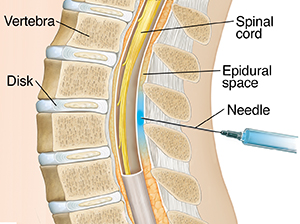A
B
C
D
E
F
G
H
I
J
K
L
M
N
O
P
Q
R
S
T
U
V
W
X
Y
Z
Back to Intro
Click a letter to see a list of conditions beginning with that letter.
Click 'Back to Intro' to return to the beginning of this section.
Anesthesia: Regional Anesthesia
You’re scheduled for surgery. During surgery, you’ll get medicine called anesthesia to keep you comfortable and pain-free. Your surgeon has decided that you’ll get regional anesthesia. This sheet tells you what to expect with this type of anesthesia.
What is regional anesthesia?
Regional anesthesia numbs one large part of your body. The anesthesia may be given around nerves or into veins in your arms, neck, or legs (nerve block or Bier block). Or it may be sent into the spinal fluid (spinal anesthesia) or into the space just outside the spinal fluid (epidural anesthesia). You may also be given sedatives to help you relax.
Nerve block or Bier block
A small part of the body, such as an arm or leg, can be numbed using a nerve block or Bier block.
-
Nerve block. During a nerve block, your skin is numbed. A needle is then inserted near nerves that serve the area to be numbed. Anesthetic is sent through the needle.
-
IV regional or Bier block. For this type of block, an IV (intravenous) line is put into a vein. The blood flow to the area to be numbed is blocked for a short time. Anesthetic is sent through the IV.
Spinal anesthesia
Spinal anesthesia numbs your body from about the waist down.
-
Anesthetic is injected into the spinal fluid. This is a substance that surrounds the spinal cord in your spinal column. The anesthetic blocks pain traveling from the body to the brain.
-
To receive the anesthetic, your skin is numbed at the injection site on your back.
-
A needle is then inserted into the spinal space. Anesthetic is sent into the spinal fluid through the needle.
Epidural anesthesia
Epidural anesthesia is most often used during childbirth. It may also be used after surgery of the chest, belly, and legs.
-
Anesthetic is injected into the epidural space. This is just outside the dural sac that contains the spinal fluid.
-
To receive the anesthetic, your skin is numbed at the injection site on your back.
-
A needle is then inserted into the epidural space. Anesthetic is sent into the epidural space through the needle.
-
A small flexible tube (catheter) may be attached to the needle and left in place. This allows for continuous injections or infusions of anesthetic.

Anesthesia tools and medicines that might be near you during your procedure
-
Local anesthetic. This medicine is given through a needle. It numbs 1 small part of your body.
-
Electrocardiography leads (electrodes). These are used to record your heart rate and rhythm.
-
Blood pressure cuff. A cuff is placed on your arm to keep track of your blood pressure.
-
Pulse oximeter. This small clip is placed on the end of the finger. It measures your blood oxygen level.
-
Sedatives. These medicines may be given through an IV. They help to relax you and keep you comfortable. You may stay awake or sleep lightly.
-
Oxygen. You may be given oxygen through a face mask.
Risks and possible complications
Regional anesthesia carries some risks. These include:
-
Upset stomach (nausea) and vomiting
-
Headache
-
Backache
-
Decreased blood pressure
-
Allergic reaction to the anesthetic
-
Ongoing numbness (rare)
-
Irregular heartbeat (rare)
-
Cardiac arrest (rare)
When to get medical care
Follow your healthcare provider's instructions after the procedure. Call your provider right away if you have any of the following:
-
Fever of 100.4°F (38.0°C) or higher, or as directed by your provider
-
Chills
-
Signs of infection at the anesthesia site, such as redness, swelling, warmth, or leaking fluid
-
Numbness that doesn’t go away
-
Trouble controlling your bladder
-
Pain that isn’t eased by medicines
-
Other symptoms as directed by your provider
Call 911
Call 911 right away if you have:
-
Shortness of breath
-
Trouble breathing
Online Medical Reviewer:
Marianne Fraser MSN RN
Online Medical Reviewer:
Melinda Murray Ratini DO
Online Medical Reviewer:
Raymond Turley Jr PA-C
Date Last Reviewed:
3/1/2024
© 2000-2024 The StayWell Company, LLC. All rights reserved. This information is not intended as a substitute for professional medical care. Always follow your healthcare professional's instructions.